Basics of Banking
The journey to financial success begins with understanding the basics of banking. Learn why you may want to use a bank, about the different types of accounts, how to manage a checking account and more.

The journey to financial success begins with understanding the basics of banking. Learn why you may want to use a bank, about the different types of accounts, how to manage a checking account and more.
A: The money you put into a bank account is insured by the Federal Deposit Insurance Corporation (FDIC), so it is safe and secure. Using bank services makes it easier and more convenient to handle your money. Also, building a relationship with a bank can help when you have future financial needs, for example getting a loan.
A: You can deposit money into and withdraw money from both savings and checking accounts. The main intent of a savings account is to grow money for emergency purposes or long-term goals. Checking accounts are used to pay everyday expenses, such as groceries, gas, rent or mortgage. Checking account balances typically fluctuate more.
A: Our downloadable Checking Smart Guide gives step-by-step instructions on writing a check.
A: A debit card, also called a check card, is tied directly to your bank account and is similar to paying with cash. Present your card or provide card information when making a purchase, and the amount is automatically deducted from your checking account. You can also use your debit card to get cash from an ATM. You will receive a personal identification number (PIN) with your debit card, which you may need to provide when using it. Be aware of any daily spending and cash withdrawal limits associated with your card. If you debit card is lost or stolen, report it to your bank immediately.
A: You should not write a check or make a debit card purchase for more money than you have available in your account. If you do, you will overdraw your account. This means you may have to pay overdraft/NSF (nonsufficient funds) fees to both the bank and the business where you wrote the check or used your debit card.
A: Keep track of how much money you have spent and how much you still have in your checking account. Our Managing Your Checking Account guide explains how to keep a checkbook register, how to understand your bank statement and how to balance your checking account.
A: Funds availability refers to how soon money that goes into your account is available for withdrawal. Typically, when you deposit cash or receive direct deposit from an employer or government entity, the money can be withdrawn immediately. It may take longer for a deposited check to be available. Each financial institution has its own specific rules as to when funds are made available. However, there is a federal regulation that they must use as a guide for designing their policies. Ask about the funds availability policy when opening an account, as it can differ between financial institutions.

When you’re starting out, you need a budgeting system. How do you keep track of what you’re spending — and make sure you’re living within your means?

Many people put off their money goals until later. Achievement happens when you start now. Learn how.

Develop this vital habit, so you’re not living paycheck to paycheck.
This is a link to a third-party site. Note that the third party's privacy policy and security practices may differ from the standards of Old National Bank. Complete details regarding third-party links are available in our Terms of Use.
Residents of California have certain rights regarding the sale of personal information to third parties. Old National Bank, our affiliates, and service providers use information collected through cookies or in forms to improve the experience on our site and pages, to analyze how our site is used, and to present personalized advertising.
At any point, you can opt-out of the sale of your personal information by selecting Do Not Sell My Personal Information.
You can find more information and how to manage your privacy choices by reviewing our California Consumer Privacy Disclosures located on our Privacy information page by following the link on the bottom of any page.